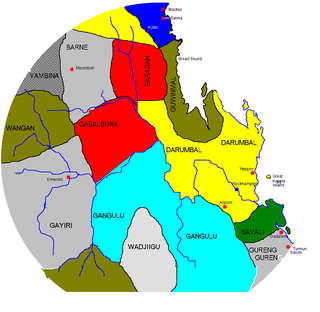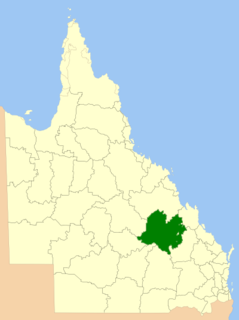Language
The Kanolu were often confused with the Kangulu, despite marked differences in their dialects. For example, 'no' was kara for the former, kagu for the latter, and the Kanolu word for 'man' was mari, in contrast to the Kangulu word for the same, bama.

The Kangulu, also written Gangulu, is an aboriginal tribe from the Mount Morgan area in Queensland, Australia.
History of contact
Native memory spoke of many members of the tribe dying out around the 1830s, from a disease which affected the nose, [lower-alpha 1] and some members of the group were seen to bear marks that might have indicated a smallpox epidemic. White settlement of Kanolu lands began around 1860. At the time their population was estimated at around 500. Within a decade, by 1869, their numbers had fallen to 300, and by 1879 it was thought no more than 200 survived. Thomas Josephson claimed that this drastic demographic decline was attributable to three factors. One was the effect of venereal disease introduced by settlers; secondly, consumption, and thirdly infanticide.

Tuberculosis (TB) is an infectious disease usually caused by Mycobacterium tuberculosis (MTB) bacteria. Tuberculosis generally affects the lungs, but can also affect other parts of the body. Most infections do not have symptoms, in which case it is known as latent tuberculosis. About 10% of latent infections progress to active disease which, if left untreated, kills about half of those affected. The classic symptoms of active TB are a chronic cough with blood-containing sputum, fever, night sweats, and weight loss. It was historically called "consumption" due to the weight loss. Infection of other organs can cause a wide range of symptoms.
Infanticide is the intentional killing of infants.
This page is based on this
Wikipedia article Text is available under the
CC BY-SA 4.0 license; additional terms may apply.
Images, videos and audio are available under their respective licenses.
The Bakanambia, also known as the Wanbara, are an Aboriginal group of Australia. Traditionally, the Bakanambia lived in the vicinity of Princess Charlotte Bay in the state of Queensland. One of the ethnonyms applied to them was Lama Lama, which is now used of a larger aggregation of remnants of several tribes.
The Badjiri or Budjari, also written Badyidi, are an Australian Aboriginal people group of Queensland. They are not to be confused with the Pitjara.
The Ngurunta or Runda are believed to have been an indigenous Australian people of the state of South Australia located immediately west of Lake Frome.
The Bibulman (Pibelmen) were an indigenous Australian people of the southwestern region of Western Australia
The Kuungkari are an indigenous Australian people of Queensland. They are to be distinguished from the Kunggari.
The Maia were an indigenous Australian tribe of Western Australia.
The Oitbi were an indigenous Australian people of the Cobourg Peninsula of the Northern Territory.
The Wadja were an indigenous Australian people of Queensland.
The Malgana are an indigenous Australian people of Western Australia.
The Bitjara or Bithara were an indigenous people of the state of Queensland. They spoke a dialect of the Ngura language. They are not to be confused with the Warrego River Pitjara or the Badjiri of the Paroo River.
The Kairi (Gayiri) were an indigenous Australian people of the state of Queensland.
The Karanja (Karanya) were an indigenous Australian people of the state of Queensland.
The Yangga were an indigenous Australian people of the state of Queensland. They are not to be confused with the Yangaa.
The Yambina were an indigenous Australian people of the state of Queensland.
The Kungadutji were an indigenous Australian people of the state of Queensland.
The Karingbal (Garaynbal) are an indigenous Australian people of the state of Queensland. They spoke a dialect of Biri.
The Kawambarai (Gawambaraay) were an indigenous Australian people of the state of New South Wales. Their domain was in the central–western district of New South Wales
The Wanjiwalku were an indigenous Australian people of the state of New South Wales.
The Iwaidja are an indigenous Australian people of the Northern Territory.





